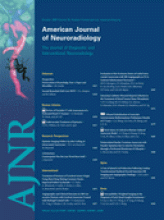Research ArticleBrain
Unilateral Hemispheric Proliferation of Ivy Sign on Fluid-Attenuated Inversion Recovery Images in Moyamoya Disease Correlates Highly with Ipsilateral Hemispheric Decrease of Cerebrovascular Reserve
M. Kawashima, T. Noguchi, Y. Takase, T. Ootsuka, N. Kido and T. Matsushima
American Journal of Neuroradiology October 2009, 30 (9) 1709-1716; DOI: https://doi.org/10.3174/ajnr.A1679
M. Kawashima
T. Noguchi
Y. Takase
T. Ootsuka
N. Kido

References
- 1.↵
- Ohta T,
- Tanaka H,
- Kuroiwa T
- 2.↵
- Maeda M,
- Tsuchida C
- 3.↵
- 4.↵
- Fukui M
- 5.↵
- Yamamoto S,
- Watanabe M,
- Uematsu T,
- et al
- 6.↵
- Iida H,
- Itoh H,
- Nakazawa M,
- et al
- 7.↵
JET Study Group. Japanese EC-IC bypass Trial (JET study): study design and interim analysis. Surg Cereb Stroke 2002;30:97–100
- 8.↵
- 9.↵
- Kawamura S,
- Ashizaki M,
- Saida S,
- et al
- 10.↵
- Yoon HK,
- Shin HJ,
- Chang YW
- 11.↵
- Ikezaki K,
- Matsushima T,
- Kuwabara Y,
- et al
- 12.↵
- Nakagawara J,
- Takeda R,
- Suematsu K,
- et al
- 13.↵
- Nariai T,
- Suzuki R,
- Matsushima Y,
- et al
- 14.↵
- Carusone LM,
- Srinivasan J,
- Gitelman DR,
- et al
- 15.↵
- Fujiwara H,
- Momoshima S,
- Kuribayashi S
In this issue
Advertisement
M. Kawashima, T. Noguchi, Y. Takase, T. Ootsuka, N. Kido, T. Matsushima
Unilateral Hemispheric Proliferation of Ivy Sign on Fluid-Attenuated Inversion Recovery Images in Moyamoya Disease Correlates Highly with Ipsilateral Hemispheric Decrease of Cerebrovascular Reserve
American Journal of Neuroradiology Oct 2009, 30 (9) 1709-1716; DOI: 10.3174/ajnr.A1679
0 Responses
Unilateral Hemispheric Proliferation of Ivy Sign on Fluid-Attenuated Inversion Recovery Images in Moyamoya Disease Correlates Highly with Ipsilateral Hemispheric Decrease of Cerebrovascular Reserve
M. Kawashima, T. Noguchi, Y. Takase, T. Ootsuka, N. Kido, T. Matsushima
American Journal of Neuroradiology Oct 2009, 30 (9) 1709-1716; DOI: 10.3174/ajnr.A1679
Jump to section
Related Articles
- No related articles found.
Cited By...
- Ivy Sign in Moyamoya Disease: A Comparative Study of the FLAIR Vascular Hyperintensity Sign Against Contrast-Enhanced MRI
- Moyamoya syndrome in sickle cell anaemia: a cause of recurrent stroke
- Elevated Cerebral Blood Volume Contributes to Increased FLAIR Signal in the Cerebral Sulci of Propofol-Sedated Children
- Hyperintense Basilar Artery on FLAIR MR Imaging: Diagnostic Accuracy and Clinical Impact in Patients with Acute Brain Stem Stroke
- Fluid-Attenuated Inversion Recovery Vascular Hyperintensities: An Important Imaging Marker for Cerebrovascular Disease
- Decrease in Leptomeningeal Ivy Sign on Fluid-Attenuated Inversion Recovery Images after Cerebral Revascularization in Patients with Moyamoya Disease
This article has not yet been cited by articles in journals that are participating in Crossref Cited-by Linking.
More in this TOC Section
Similar Articles
Advertisement











